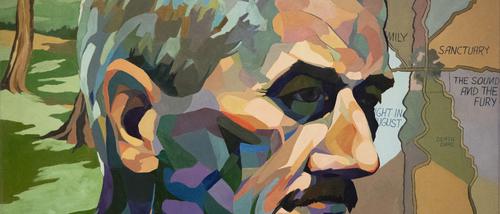As part of its celebration of the William Faulkner Centennial, the Center for Faulkner Studies commissioned Dr. Grant Lund, a Southeast Missouri State University professor of art, to design and execute a mural of Faulkner.
Completed in July 1997, the mural occupies a 10-by-9-foot wall outside the original home of the Center for Faulkner Studies in Kent Library, room 309. The painting is accompanied by an excerpt from Faulkner's Nobel Prize acceptance speech.
Words about the Mural from its Creator, Dr. Grant Lund
As an artist/teacher I have sought to give purpose and meaning to my creative life. I have not always succeeded. But I have tried by looking to others who have struggled with their own creative efforts. As Faulkner said,
The kindest thing the gods can give people at twenty . . . is a capacity to ask why, a passion for something better than vegetation, even if what they get by it is grief and pain.
Faulkner left an enduring residue from his experiences as an example for us who strive to create. A contemporary with Faulkner wrote:
There is no greater persuader than art
When it is permitted to touch the vital nerves.
There is nothing more frivolous than art
When it is denied access to the sources of life.
A Time to Speak by Archibald MacLeish 1940
This has been on my office door for the past four years. In addition, I have also given many students Faulkner’s Nobel Prize Acceptance Speech as class reading. "The problems of the human heart in conflict with itself" particularly seems to touch the vital nerves. When Bob Hamblin approached me about the Faulkner mural, it fit and I readily accepted the opportunity and challenge.
As Bob and I talked about the work of Faulkner, it struck me forcibly that the form of the mural should be a metaphor for the content. The critic Clifton Fadiman had called his work a "psychological jigsaw puzzle." Up close with different narrators it is hard to tell how the pieces fit. From a psychological distance they make sense. The placement of the mural had the same dual challenge. It would be at the top of the stairs - right in your face - and it would be viewed from down the library’s third floor hall which would increase perceptual distance. Faulkner, while in Paris, "absorbed modernism" and the mural reflects the duality of abstractness and realism of both his life and his writing.
Faulkner was a person of great polarities. This was sought in the mural through the psychological expression of the form. He was a person who at times was brooding, curt, and critical of the society he saw and yet was willing to work with young students and to tour parts of the Orient, Europe, and South America to encourage individual freedom as espoused by the United States. As a writer he was often accused of writing of despair and degradation, yet he gave one of the most remembered Nobel Prize acceptance speeches on the importance of the individual and the hope of man. His writings on close examination seem "difficult and impenetrable," but with proper perspective give a clear psychological insight into the functioning of the human heart in conflict with itself.
One pictorial polarity was of his real home Rowan Oak, which served as the deep roots and well spring of his creative life, and the opposing map of the imaginary Jefferson and Yoknapatawpha County. But even here there was some artistic license. His backward Ns are an example.
The mural was designed to reflect these polarities. As the viewer ascends the steps the closeness and size of Faulkner’s image shifts the focus to the forms of color and shape. The deep purples, strong greens, and contrasting blues of the shadows are all at approximately eye level and carry the psychological brooding for which Faulkner and his writing are both known. The warm colors of the highlights reflect his sensitivity and compassion for which he was also known. You see parts more than the whole with each color and shape having strong individual strength. The precision of his acceptance speech words are juxtapositioned with the intuitively felt image. As the viewer moves down the hall the scale shifts, the "gestalt" occurs and parts are transformed to create a whole.
Synergistic polarities require both form and content to be equally strong and able to stand on their own, but the energy comes from the relationship and not from the sum of the parts. Synergism is multiplication, not just addition. Neither polarity is servant to the other, but are marriage partners. Like night and day, like winter and summer, the distance allowed between them becomes the source of psychological as well as real energy as long as they synergistically interact. When the interaction is fused or finished, when isolated form becomes just "decoration" or when isolated content becomes just "illustration," when one is the servant to the other the muddy middle indicates that the energy is gone. Constant winter or constant summer destroys. For Faulkner readers the energy still remains.
This same type of energy was the objective of the mural designer. The real emerging from the abstract, the warm against the cool colors, the brooding psychological depth as part of the dignified attractive southern gentleman, the reality of Rowan Oak against the fantasy of Yoknapatawpha County, words juxtapositioned with images were all efforts to capture the essence of the content in the form.
Cape Girardeau, MO 63701
